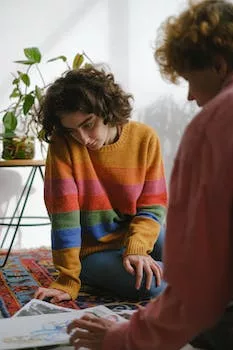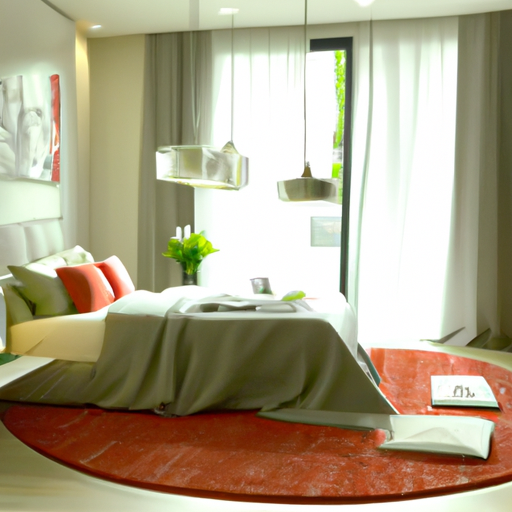Master Suite Design Elements: Key Features for a Luxurious Retreat
The importance of design in creating a home that’s perfect for a master suite cannot be overstated. A well-designed master suite serves as a luxurious retreat, a sanctuary where homeowners can unwind and relax after a long day. It is a space that should be both functional and aesthetically pleasing, reflecting the personal style and preferences of the homeowner. In order to achieve this, there are several key design elements that should be considered when planning a master suite.
First and foremost, the layout of the master suite is crucial in ensuring that the space is both comfortable and functional. The size and shape of the room will dictate the placement of furniture and other design elements, so it is important to carefully consider the dimensions of the space. Ideally, the master suite should be spacious enough to accommodate a king-sized bed, as well as additional seating and storage options. Additionally, the layout should allow for easy movement throughout the space, with clear pathways between the bed, seating areas, and any doors or windows.
Another important aspect of master suite design is the choice of color palette. The colors used in the space should evoke a sense of calm and relaxation, as well as complement the overall design aesthetic of the home. Neutral tones, such as beige, gray, and white, are popular choices for master suites, as they create a soothing atmosphere and can easily be paired with a variety of accent colors. However, homeowners should not be afraid to experiment with bolder hues, as long as they are used in moderation and balanced with more subdued shades.
Lighting is another key design element that can greatly impact the overall ambiance of a master suite. A combination of ambient, task, and accent lighting should be used to create a layered lighting scheme that is both functional and visually appealing. Ambient lighting, such as recessed ceiling lights or a chandelier, provides general illumination for the space, while task lighting, such as bedside lamps or reading lights, is essential for specific activities. Accent lighting, such as wall sconces or LED strip lights, can be used to highlight architectural features or artwork, adding depth and dimension to the space.
In addition to lighting, window treatments play a significant role in the overall design of a master suite. They not only provide privacy and light control but also contribute to the room’s aesthetic. High-quality curtains, blinds, or shades should be chosen to complement the color palette and design style of the space. Additionally, the window treatments should be properly installed and maintained to ensure that they function effectively and look their best.
Finally, the furnishings and accessories used in a master suite should be carefully selected to create a cohesive and luxurious design. High-quality furniture, such as a comfortable bed, stylish seating options, and ample storage solutions, is essential for a functional and inviting space. Additionally, accessories, such as decorative pillows, artwork, and area rugs, can be used to add personality and visual interest to the room.
In conclusion, the design of a master suite is of utmost importance in creating a luxurious retreat that homeowners can enjoy for years to come. By carefully considering the layout, color palette, lighting, window treatments, and furnishings, a well-designed master suite can provide a sanctuary that is both functional and aesthetically pleasing. With thoughtful planning and attention to detail, homeowners can create a master suite that truly reflects their personal style and preferences, resulting in a space that is truly their own.
Balancing Functionality and Aesthetics: Tips for Designing the Ultimate Master Suite

The importance of design in creating a home that’s perfect for a master suite cannot be overstated. A well-designed master suite serves as a sanctuary for homeowners, providing a space where they can relax, unwind, and enjoy some much-needed privacy. Balancing functionality and aesthetics is crucial in designing the ultimate master suite, as it ensures that the space is not only visually appealing but also practical and comfortable. In this article, we will explore some tips for achieving this delicate balance and creating a master suite that truly stands out.
First and foremost, it is essential to consider the layout of the master suite. The layout should be designed in such a way that it maximizes the available space while also providing a sense of flow and harmony. This can be achieved by carefully considering the placement of key elements such as the bed, seating areas, and storage solutions. For instance, placing the bed in a central location with ample space around it can create a sense of grandeur and luxury, while also allowing for easy movement throughout the room. Additionally, incorporating seating areas and storage solutions in a thoughtful manner can help to create a cohesive and functional space.
Another important aspect of designing the ultimate master suite is the choice of color palette. The colors used in the space should not only be visually appealing but also evoke a sense of calm and relaxation. Neutral tones such as beige, gray, and white are often popular choices for master suites, as they create a soothing and tranquil atmosphere. However, homeowners should not be afraid to incorporate bolder colors or patterns if they feel it will enhance the overall aesthetic of the space. The key is to strike a balance between bold and subtle elements, ensuring that the space remains visually interesting without becoming overwhelming.
Lighting is another crucial element in designing a master suite that balances functionality and aesthetics. The space should be well-lit, with a combination of ambient, task, and accent lighting to create a warm and inviting atmosphere. Ambient lighting can be achieved through the use of ceiling fixtures, chandeliers, or recessed lighting, while task lighting can be provided by bedside lamps or reading lights. Accent lighting, such as wall sconces or floor lamps, can be used to highlight architectural features or artwork, adding an extra layer of visual interest to the space.
In addition to lighting, the choice of window treatments can also play a significant role in creating a master suite that is both functional and aesthetically pleasing. Window treatments should not only provide privacy and light control but also complement the overall design of the space. For instance, floor-to-ceiling curtains can add a sense of drama and elegance to the room, while also providing the necessary privacy and light control.
Finally, the selection of furniture and accessories is crucial in designing a master suite that strikes the perfect balance between functionality and aesthetics. The furniture should be comfortable and practical, with pieces such as a bed, nightstands, and seating areas that serve a specific purpose. Additionally, the accessories used in the space should be carefully chosen to enhance the overall design and create a cohesive look. This can include items such as artwork, decorative pillows, and area rugs, which can add texture, color, and visual interest to the space.
In conclusion, designing the ultimate master suite requires a careful balance of functionality and aesthetics. By considering elements such as layout, color palette, lighting, window treatments, and furniture and accessories, homeowners can create a space that is not only visually appealing but also practical and comfortable. With thoughtful planning and attention to detail, a master suite can truly become a sanctuary within the home.
The Art of Relaxation: How Design Choices Impact the Comfort and Ambiance of a Master Suite
The importance of design in creating a home that’s perfect for a master suite cannot be overstated. A well-designed master suite serves as a sanctuary, a place where homeowners can retreat to relax and rejuvenate after a long day. It is a space that should be both functional and aesthetically pleasing, reflecting the personal tastes and preferences of the homeowner while also providing a comfortable and inviting atmosphere. In this article, we will explore the various design choices that can impact the comfort and ambiance of a master suite, and how these elements can be thoughtfully incorporated to create the ultimate haven for relaxation.
One of the most critical aspects of designing a master suite is the layout. The layout should be carefully considered to ensure that the space is both functional and visually appealing. This includes the placement of the bed, which should be positioned to allow for easy access to both sides, as well as the inclusion of ample storage space for clothing and personal items. Additionally, the layout should take into consideration the flow of traffic through the space, ensuring that there are no obstructions or awkwardly placed furniture that could impede movement.
Another essential element of master suite design is the choice of color palette. The colors used in the space can have a significant impact on the overall ambiance and mood. Soft, neutral tones such as beige, gray, and white can create a calming and serene atmosphere, while bolder hues like navy, emerald, or even black can add a touch of drama and sophistication. Ultimately, the choice of color palette should reflect the homeowner’s personal style and preferences, while also considering the impact that certain colors can have on the overall mood and atmosphere of the space.
Lighting is another crucial factor in creating a comfortable and inviting master suite. The space should be well-lit, with a combination of ambient, task, and accent lighting to provide the appropriate level of illumination for various activities. Ambient lighting, such as recessed ceiling lights or a chandelier, can create a soft, diffused glow that fills the room, while task lighting, such as bedside lamps or reading lights, can provide focused illumination for specific tasks. Accent lighting, such as wall sconces or decorative fixtures, can add visual interest and highlight architectural features or artwork.
The choice of materials and finishes used in the master suite can also greatly impact the overall comfort and ambiance of the space. High-quality materials, such as hardwood flooring, natural stone countertops, and plush textiles, can create a sense of luxury and refinement. Additionally, the use of soft, tactile fabrics for bedding, window treatments, and upholstery can add an extra layer of comfort and warmth to the space.
Finally, the inclusion of personal touches and decorative elements can help to make the master suite feel truly unique and tailored to the homeowner’s tastes and preferences. This can include the display of personal artwork, the incorporation of cherished mementos, or the use of custom-designed furniture pieces. By thoughtfully curating these elements, homeowners can create a space that feels truly personal and reflective of their individual style.
In conclusion, the design choices made when creating a master suite can have a significant impact on the overall comfort and ambiance of the space. By carefully considering the layout, color palette, lighting, materials, and personal touches, homeowners can create a sanctuary that is both functional and aesthetically pleasing, providing the perfect retreat for relaxation and rejuvenation.
Q&A
Question 1: Why is design important in creating a perfect master suite?
Answer: Design is important in creating a perfect master suite because it ensures that the space is functional, comfortable, and aesthetically pleasing. A well-designed master suite will cater to the homeowner’s needs, preferences, and lifestyle, ultimately providing a personal sanctuary that promotes relaxation and rejuvenation.
Question 2: How can design elements enhance the overall ambiance of a master suite?
Answer: Design elements such as color schemes, lighting, furniture, and layout can significantly enhance the overall ambiance of a master suite. By carefully selecting and coordinating these elements, homeowners can create a cohesive and harmonious space that reflects their personal style and promotes a sense of tranquility and well-being.
Question 3: What are some key design considerations when planning a master suite?
Answer: Some key design considerations when planning a master suite include the size and layout of the space, the desired level of privacy, storage needs, and the integration of technology and amenities. Additionally, it is essential to consider the overall style and theme of the home, as well as the homeowner’s preferences and lifestyle, to create a master suite that is both functional and visually appealing.
Conclusion
In conclusion, the importance of design in creating a home that’s perfect for a master suite lies in its ability to enhance comfort, functionality, and aesthetics. A well-designed master suite not only serves as a personal sanctuary for relaxation and rejuvenation but also adds value to the property by meeting the needs and preferences of homeowners.


